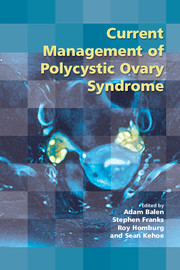Book contents
- Frontmatter
- Contents
- Participants
- Declarations of personal interest
- Preface
- 1 Overview and definitions of polycystic ovary syndrome and the polycystic ovary
- 2 Genetics and pathogenesis of polycystic ovary syndrome
- 3 Ethnic variations in the expression of polycystic ovary syndrome
- 4 Quality of life for women with polycystic ovary syndrome
- 5 Insulin resistance, the metabolic syndrome and polycystic ovary syndrome
- 6 Management of polycystic ovary syndrome through puberty and adolescence
- 7 Long-term health risks of polycystic ovary syndrome
- 8 Approaches to lifestyle management in polycystic ovary syndrome
- 9 Management of obesity in polycystic ovary syndrome, including anti-obesity drugs and bariatric surgery
- 10 Definition of hyperandrogenism
- 11 Treatment of hyperandrogenism in polycystic ovary syndrome
- 12 Choices in the treatment of anovulatory polycystic ovary syndrome
- 13 Predictors of ovarian response to ovarian stimulation: progress towards individualised treatment in ovulation induction
- 14 Surgical management of anovulatory infertility in polycystic ovary syndrome
- 15 The role of insulin-sensitising drugs in the treatment of polycystic ovary syndrome
- 16 The role of in vitro maturation of oocytes for anovulatory polycystic ovary syndrome
- 17 Acupuncture and/or herbal therapy as an alternative or complement for relief of polycystic ovary syndrome-related symptoms
- 18 Consensus views arising from the 59th Study Group: Current Management of Polycystic Ovary Syndrome
- Index
17 - Acupuncture and/or herbal therapy as an alternative or complement for relief of polycystic ovary syndrome-related symptoms
Published online by Cambridge University Press: 05 July 2014
- Frontmatter
- Contents
- Participants
- Declarations of personal interest
- Preface
- 1 Overview and definitions of polycystic ovary syndrome and the polycystic ovary
- 2 Genetics and pathogenesis of polycystic ovary syndrome
- 3 Ethnic variations in the expression of polycystic ovary syndrome
- 4 Quality of life for women with polycystic ovary syndrome
- 5 Insulin resistance, the metabolic syndrome and polycystic ovary syndrome
- 6 Management of polycystic ovary syndrome through puberty and adolescence
- 7 Long-term health risks of polycystic ovary syndrome
- 8 Approaches to lifestyle management in polycystic ovary syndrome
- 9 Management of obesity in polycystic ovary syndrome, including anti-obesity drugs and bariatric surgery
- 10 Definition of hyperandrogenism
- 11 Treatment of hyperandrogenism in polycystic ovary syndrome
- 12 Choices in the treatment of anovulatory polycystic ovary syndrome
- 13 Predictors of ovarian response to ovarian stimulation: progress towards individualised treatment in ovulation induction
- 14 Surgical management of anovulatory infertility in polycystic ovary syndrome
- 15 The role of insulin-sensitising drugs in the treatment of polycystic ovary syndrome
- 16 The role of in vitro maturation of oocytes for anovulatory polycystic ovary syndrome
- 17 Acupuncture and/or herbal therapy as an alternative or complement for relief of polycystic ovary syndrome-related symptoms
- 18 Consensus views arising from the 59th Study Group: Current Management of Polycystic Ovary Syndrome
- Index
Summary
Introduction
The theory of traditional Chinese medicine (TCM) and its clinical application has a long tradition and gynaecology is one of four major clinical sciences of TCM (the other three being internal medicine, surgery and paediatrics). Western medicine and TCM are opposites in many respects: Western medical science works from basic science and a clinical evidence-based perspective while TCM evolves from a holistic and macroscopic perspective.
Acupuncture (Latin acus meaning needle and punctura meaning puncture) is a method of treatment that dates back at least 3000 years. It is an integral part of TCM and over the past decade it has become established in Western medicine. Herbal medicine is another important part of TCM. However, owing to the mix of different herbs and the lack of studies of specific mechanism of action, it is difficult to interpret the results.
Attempts to merge Western and Chinese medical systems have not, in general, been successful and, owing to the lack of scientific documentation or poor research methodology, there is scepticism over the effects claimed for acupuncture and for various herbs and herbal formulations. One reason may be that the underlying mechanisms of acupuncture are most often described in the language of TCM and are rarely discussed in terms of biological events. However, in recent years the effect of particularly acupuncture on various conditions (pain and diseases) has been studied from a Western scientific perspective and the results show that acupuncture may have both a physiological and a psychological impact. Still, the many different styles of acupuncture practice and lack of agreement on the optimal acupuncture treatment for any particular condition may mean that some patients do not receive the best treatment. This uncertainty also makes the negative results of sham-controlled trials difficult to interpret. Unless we can be sure that both adequate acupuncture and an inactive sham were used in a particular trial, then that trial should not be interpreted as dismissing acupuncture for that condition.
Keywords
- Type
- Chapter
- Information
- Current Management of Polycystic Ovary Syndrome , pp. 195 - 212Publisher: Cambridge University PressPrint publication year: 2010



